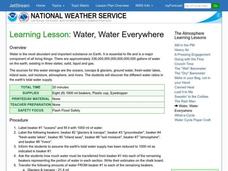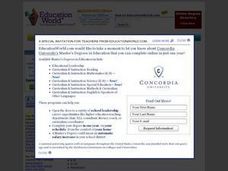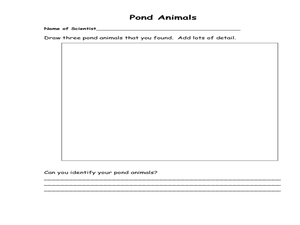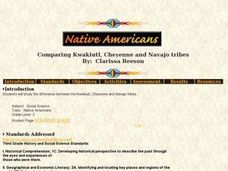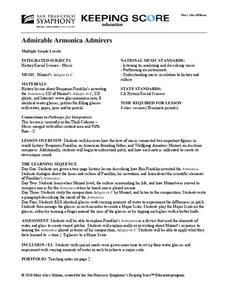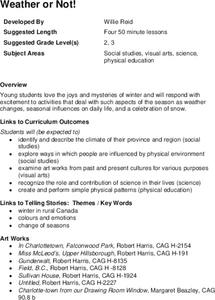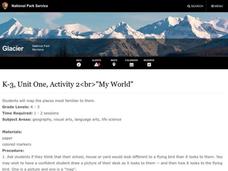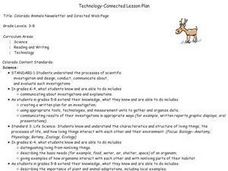Curated OER
Mud in the Water
Students build a soil erosion model to study the importance of soil conservation. They investigate how land forms from both constructive and destructive forces.
Curated OER
Water, Water Everywhere
Students estimate the amount of water that can be found in its various forms including oceans, lakes, glaciers, rivers, etc. They view a demonstration about water distribution and discuss flash flooding safety precautions.
Curated OER
Rainforest Problem
Third graders use a hypothetical story in order to create a context for the lesson. The story presents a problem that needs to be solved. They write a letter to a government official as part of the lesson.
Curated OER
Arabian Camel or Dromedary
In this camel worksheet, students study the diagram for an Arabian camel otherwise known as a dromedary. Students read the characteristics of the animal and may click on associated links to learn more.
Curated OER
Natural Selection and the Peppered Moth
Young scholars study natural selection and its process in the peppered moth. In this evolution lesson, students read about the concept of natural selection as suggested by Charles Darwin. Young scholars then complete a natural selection...
Curated OER
Marmots: Groundhogs of the World
Students research 14 groundhog species found around the world, including the woodchuck. They use the internet to research groundhogs and students organize their information using a graphic organizer.
Curated OER
Pond and Pond Organisms
Students explore pond ecosystems. In this pond organism activity, students will use pond water and a plastic bad in order to locate and identify freshwater organisms. The activity is designed for younger grades, but...
Curated OER
Fish Communities in the Hudson
Learning to read data tables is an important skill. Use this resource for your third, fourth, or fifth graders. Learners will will study tables of fish collection data to draw conclusions. The data is based on fish environments in the...
Curated OER
Writing a Historical Poem
Students work together to research a historical event. They create their own poems based on their research. They share their poems with the class and discuss the historical event further.
Curated OER
Get Educated During Childhood Obesity Awareness Month
Twenty-three million American kids are overweight and at risk for type 2 diabetes, high blood pressure, heart disease, and stroke during childhood.
Curated OER
Grid Frame Mapping
Young scholars map and describe small area of the schoolyard and discuss habitats.
Curated OER
Molly Pitcher -- "Out of Many, One"
Students research, brainstorm and analyze the events that lead up to the Revolutionary War. They critique a piece of artwork depicting a scene from the Revolutionary War. Each major battle is plotted on a map to show a visual...
K12 Reader
Using a Timeline
Introduce you primary graders to timelines with a worksheet that not only explains what this convenient tool is and how it can be used, but also describes how to construct one.
Curated OER
Comparing Kwakiutl, Cheyenne and Navajo tribes
Third graders study the difference between the Kwakiutl, Cheyenne and Navajo tribes. They identify the people, resources, lifestyle and beliefs of the Kwakiutl, Cheyenne, and Navajo Indians. Afterward, they present their projects on each...
San Francisco Symphony
Admirable Armonica Admirers
What do Ben Franklin and Wolfgang Mozart have in common? Find out about the musical invention, the armonica or glassy-chord. Learners will read about how Ben Franklin invented this new instrument and how Wolfgang Mozart came to play it....
Spreading Gratitude Rocks
Gratitude Quote Poster
According to Cicero, "Gratitude is not only the greatest of virtues, but the parent of all others." Pupils explore similar inspirational quotes after watching a time-lapse video. Next, scholars interpret one of the quotes by creating...
Curated OER
What Have You Learned about the Mouth?
Students sequence the steps in a normal day that can lead to tooth decay and describe how to maintain a healthy mouth.
Curated OER
Weather or Not!
Students are introduced to the different climate regions of Canada. In groups, they discuss ways in which people are affected by the weather and how it limits their outdoor activities. They use artwork by Robert Harris to predict what...
Curated OER
Animal Masks
Students design and make animal masks. In this research and application lesson, students use a computer to research what a panther eats, select an animal mask they want to make and then use the materials provided to create their...
Curated OER
M&M Probability
Students apply the scientific method in order to determine the probability of specific colors in a bag of M&M's. They determine the definition of probability and how it can be used. They make a hypothesis and conduct an experiment to...
Curated OER
My World
Students study maps. In this social studies lesson, students draw a map of either their room at home or the route they take to school. Students label items on their maps.
Curated OER
The Human Memory
This is a well-designed, creative lesson to help young scholars learn more about the human memory. Working in pairs, students complete tasks and gather data. Excellent websites for resources are also provided.
Curated OER
My Favorite Animal and Me
Students research their favorite animal. They create their own fact book to share about their animal and their habitat.
Curated OER
Colorado Animals Newsletter and Directed Web Page
Students select a Colorado animal, develop a Directed Web page, and research their animal. Each member of the group combine their research and develop a Newsletter.

